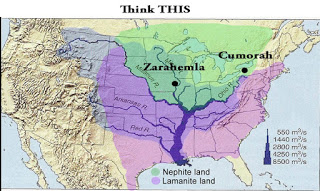For Moroni’s America (the North American setting), I used these rules of interpretation:
1. General terms (land northward, land southward) are relative terms. E.g., Salt Lake City is “northward” of Provo but “southward” of Ogden.
2. Different specific terms mean different things; i.e., the “narrow neck” is not the same as the “small neck,” the “narrow neck” is not the same as the “narrow neck of land,” etc.
3. The Nephites used rivers for travel. E.g., Helaman 3:14 But behold, a hundredth part of the proceedings of this people, yea, the account of the Lamanites and of the Nephites, and their wars, and contentions, and dissensions, and their preaching, and their prophecies, and their shipping and their building of ships…
4. The Hill Cumorah of Mormon 6:6 is in New York because Joseph and Oliver said it was a fact, they had visited the repository in the hill, and all their contemporaries and successors reaffirmed the New York Cumorah.
5. The city of Zarahemla may be across from Nauvoo. (D&C 125).
When you apply these rules of interpretation, it’s pretty easy to see how the Book of Mormon describes North America.
1. General terms (land northward, land southward) are proper nouns; i.e., there is only one “Land Northward” and one “Land Southward,” both of them being specific geographical areas.
2. Different specific terms mean the same things; i.e., the “narrow neck” is the same as the “small neck,” the “narrow neck” is the same as the “narrow neck of land,” etc.
3. The Nephites may have used rivers for travel, but most travel was overland through jungles and mountains.
4. The Hill Cumorah of Mormon 6:6 is not in New York because the prophets were only expressing their opinions and they were wrong.
5. The city of Zarahemla cannot be across from Nauvoo.
When you apply these rules of interpretation, it’s pretty easy to see how the Book of Mormon describes any location you want.
Source: About Central America

